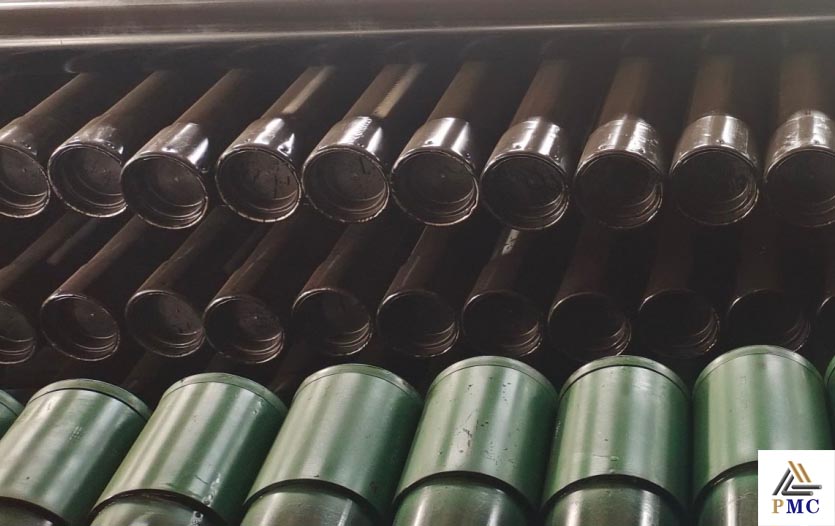
Four Performances of Oil Well Pipe
(1) Anti-sticking performance
According to standard requirements, make-up and break-out tests are required for threaded joints of oil casings. It is stipulated that each joint must be made up and broken down 6 times. Fasten up to the maximum torque recommended by the manufacturer, then loosen it, and check the adhesion of the inner and outer threads of the oil casing. The sticking and fastening of oil and casing threads is related to factors such as thread quality, thread surface hardness, make-up speed, surface friction coefficient and contact stress (coupling torque). In order to improve the anti-sticking performance of the oil casing thread, the smoothness of the thread and the hardness and uniformity of the thread should be improved, and the make-up speed should be reduced and the screwing torque should be controlled. At the same time, the surface of the inner thread of the coupling should be plated A layer of soft metal or non-metal film separates the pipe body of the oil casing from the coupling, prevents the metal surface between the two threads from bonding, and prevents the thread from being torn or even torn. Before the coupling is screwed, the thread surface needs to be coated with thread grease to prevent the thread from sticking after the coupling is screwed, and to improve the sealing performance of the thread.

There are many coating methods on the thread surface of couplings: such as galvanizing process and phosphating process; for some special materials and special connection threads, copper plating is often required. Gluing factors related to the factory: thread parameters (pitch, tooth height, taper, tight moment, tooth half-angle, etc.), internal and external thread matching (surface treatment, surface finish, phosphating, galvanizing, copper plating, etc.), thread Grease (function: lubrication, filling and sealing, etc., composed of metal powder and grease), make-up control (make-up torque, make-up speed, etc.), material factors, etc.
Sticking factors related to oilfield operation: lifting without wire protection, deflected buckle (the pipe swings in the air and the well buckle is not concentric), no buckle or less buckle, thread grease (not meeting the standard requirements, sand sundries), make-up speed and make-up torque, and clamping force of tongs, etc.
(2) Anti-collapse (crushing) performance
As the drilling depth increases, the pressure on oil and casing in oil and gas wells increases, especially in deep wells, ultra-deep wells, or formations that need to be isolated from plastic flow (such as in rock salt, salt paste, shale, soft rock formations), etc. It is more obvious in oil and gas wells in complex formations. When the external pressure bears exceeds a certain limit, the oil well tubular body will produce groove-shaped or elliptical deformation, which is called oil well tubular collapse.
(3) Corrosion resistance
Some oil and gas fields contain a large amount of corrosive media such as hydrogen sulfide, carbon dioxide or chloride ions, and require corrosion resistance for oil casings, including resistance to sulfide stress corrosion, CO2 and Cl- corrosion resistance, etc. The corrosion resistance of the oil casing is mainly related to the chemical composition of the steel and the residual stress value of the steel pipe and other factors. Reducing the content of non-metallic inclusions and harmful elements in steel, increasing corrosion-resistant elements such as Cr and Ni, reducing residual stress in steel pipes, and increasing the yield ratio of steel pipes are all conducive to improving the corrosion resistance of oil casings.
(4) Perforation performance
The oil production part of the oil layer casing (separate oil production in a multi-layer oil well) needs to be perforated to allow crude oil to flow into the casing from the designated oil-bearing oil sand layer.For this reason, the oil layer casing is required to have good perforation performance, especially when the perforation operation without gun body is adopted, the perforation performance of the casing is required to be higher.
The perforation performance of the casing is obtained through the perforation test, that is, the tested casing is suspended in the simulated well, and a series of shaped charges with a certain number, a certain distance, and different directions are hung in the casing. Then perforate. After perforation, if there are basically no cracks around the holes of the test casing, the perforation performance is evaluated as good; if there are a small amount of small cracks around each hole, but their number and length do not exceed the specifications specified in the technical conditions, then the evaluation of perforation performance is good. If the number or length of cracks around each hole exceeds the specification, especially if the cracks between two adjacent holes are connected, the perforation performance is evaluated as unqualified. The oil field also has clear requirements on the amount of expansion of the casing after perforation and the height of the inner and outer burrs around the hole.
Go here to learn more about " Seamless casing vs ERW casing "


